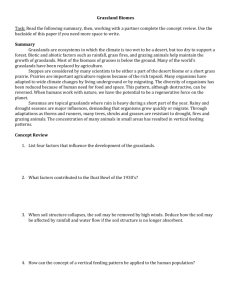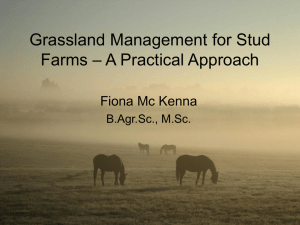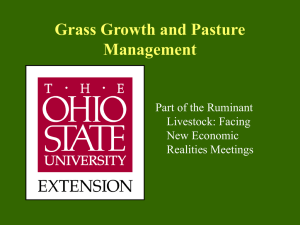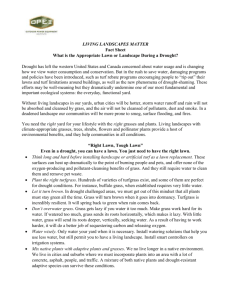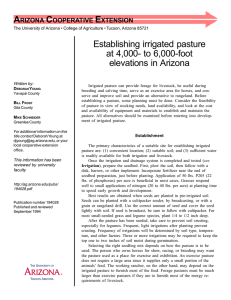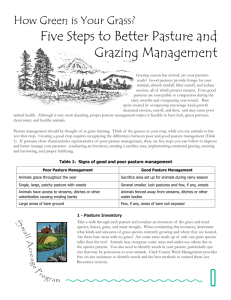Benefits of Native Pastures (Accessible Word
advertisement
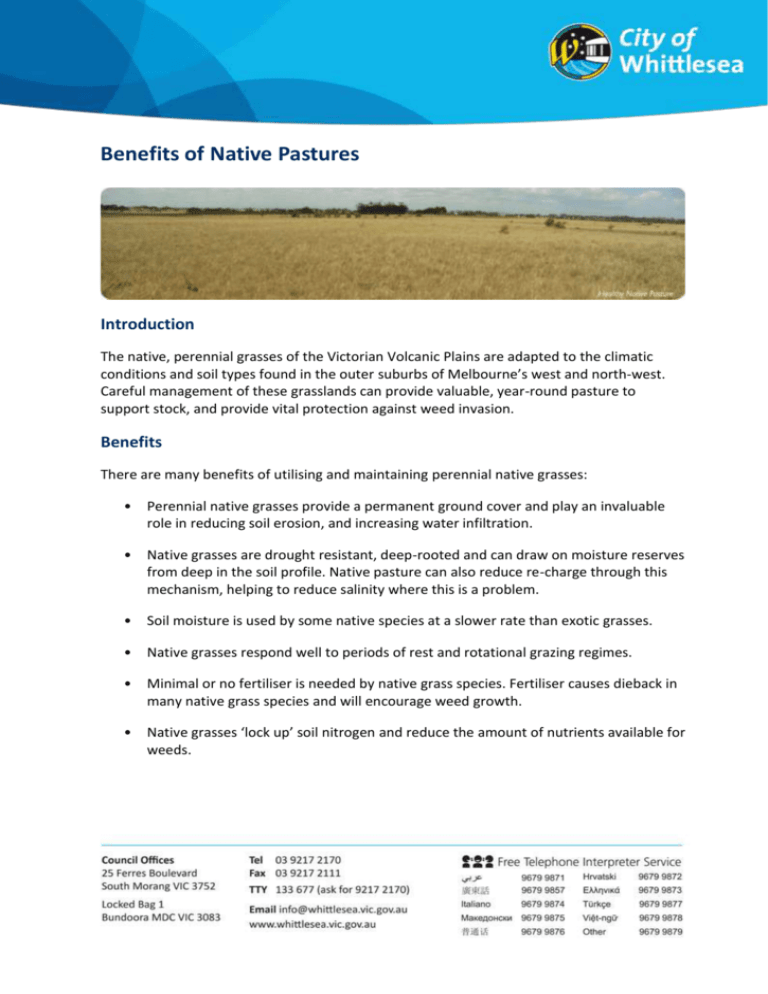
Benefits of Native Pastures Introduction The native, perennial grasses of the Victorian Volcanic Plains are adapted to the climatic conditions and soil types found in the outer suburbs of Melbourne’s west and north-west. Careful management of these grasslands can provide valuable, year-round pasture to support stock, and provide vital protection against weed invasion. Benefits There are many benefits of utilising and maintaining perennial native grasses: • Perennial native grasses provide a permanent ground cover and play an invaluable role in reducing soil erosion, and increasing water infiltration. • Native grasses are drought resistant, deep-rooted and can draw on moisture reserves from deep in the soil profile. Native pasture can also reduce re-charge through this mechanism, helping to reduce salinity where this is a problem. • Soil moisture is used by some native species at a slower rate than exotic grasses. • Native grasses respond well to periods of rest and rotational grazing regimes. • Minimal or no fertiliser is needed by native grass species. Fertiliser causes dieback in many native grass species and will encourage weed growth. • Native grasses ‘lock up’ soil nitrogen and reduce the amount of nutrients available for weeds. Strategies Native perennial grasses need to set and drop seed to allow adequate recruitment of new generations of plants. This will assist in pasture regeneration, health and vigour, and provide competition against weeds becoming established. Careful grazing management is critical for pasture health and regeneration. Cell-grazing or removal of stock at times of seed-set will help to maintain a healthy pasture. Resting pasture in spring is recommended to provide native grass and flowering herb species time to recover from grazing pressure. Alternatively, cellgrazing to allow at least every part of the property a spring rest every 2 years will greatly assist in native pasture regeneration and health. Rotate grazing in winter to maintain 1,000 Kg green DM/ha (dry matter per hectare) to encourage growth of native species. In summer, retain a litter layer and dry matter levels of 1,600 - 2,000 Kg DM/ha. Maintain at least 80% ground-cover of pasture; less than this can make it difficult to control the spread of annual weeds. As a rule of thumb, pastures should not be grazed lower than ankle height. For assistance on grazing strategies, contact the Department of Sustainability and Environment (DSE) on 136 186. The Department of Primary Industries (DPI) have a range of useful and informative Landcare and Ag Notes available on their website Department of Sustainability and Environment (DSE): • Grazing Management for Horses (AG 1054) • Drought Planning for Horses (AG 1050) • Management of Beef Cattle in a Drought (AG 1029) • Protecting the Land in Dry Times (LC 0076). Dangers of overgrazing Overgrazing leads to land degradation by eliminating the larger grasses as well as reducing the total biomass amount. Less organic matter is available to maintain soil condition, soil pore structure is affected, and rainfall infiltration is reduced. This will result in poor soil conditions such as soil acidification and soil salinity, adversely affecting plant growth. Overgrazing also provides an opportunity for weeds to become established and spread – stock will preferentially graze palatable pasture leaving unpalatable weeds such as serrated tussock to Page 2 of 5 mature and reproduce, increasing the level of weed infestation. Overgrazing will also increase the likelihood of areas being completely denuded of ground-cover, leading to further soil compaction and wind erosion. Information about land degradation caused by overgrazing is available on DPI’s website. Get to know your grass Identifying the dominant native grass species on your property will help to determine the grazing regime best suited to your property. Native grasses are divided into two different types according to their different photosynthetic pathways - C3 grasses, which grow in winter and C4 grasses, which grow in summer. A property dominated by C4 grasses can be rested every second year over summer in order to allow seed-set of these grass species, whereas a property dominated with C3 grasses will need to be rested over spring. Generally, because most native grasses and herbs flower in spring, resting for two months during this period of the year will have the most benefit. The occasional rest over summer every few years will also benefit plants that flower later in the year. Advice from DSE or your Council’s Environment Department will be able to assist in identifying the types of grass on your property. DSE can also provide assistance on pasture management for grazing. Information contained in DPI’s Native Grass AG Note (AG 0720), available on their website, can help in identifying native grass species. Intrinsic value of native grasslands The areas of native grasslands found in Whittlesea and neighbouring municipalities are part of the Victorian Volcanic Plains Grasslands, an engendered EVC (Ecological Vegetation Class), of which less than 1% of its original range exists. These grasslands are home to a number of rare and endangered plants and animals. Spring can provide a colourful display of native flowing herbs which can be a very useful indicator of a healthy native grassland. Feed value of native grasses compared to exotic pasture species The following two tables provide a comparison of the feed value of native grasses compared to exotic pasture species. Values should be used as a guide only as nutritional values vary between locations. Due to the lack of feed value data available on native pasture, only limited direct comparisons can be made between exotic and native pasture. Page 3 of 5 Native grass species C3/ C4 Crude Protein Digestibility Forage Value Drought Tolerate Tolerance Grazing Wallaby Grass (Austrodanthonia spp.) C3 Up to 25% 45-82% Moderate - High High Yes Spear Grass (Austrostipa spp.) C3 Up to 17% <60% Low Moderate High Light Red-leg Grass (Bothriochloa macra) C4 Up to 15% 48-59% Low Moderate High Yes Windmill Grass (Chloris truncata) C4 Up to 12% 35-68% Moderate High Yes Weeping Grass (Microlaena stipoides) C3 Up to 27% 55-80% High High Yes Kangaroo Grass (Themeda triandra) C4 Up to 17% 54-75% Moderate - High High Light Common Wheat Grass (Elymus scaber) C3 Up to 36% 53-90% Moderate - High Moderate Yes Exotic grass species CP % ADF % DDM % ME Australian Phalaris 13.75 – 15 29 – 35.1 61 – 66 9.1 – 9.9 Currie Cocksfoot 16.25 – 18.1 32.5 – 34.1 62 – 64.5 9.4 – 9.7 Demeter Fescue 13.75 – 15.1 31.3 – 34.3 61 – 64.3 9.2 – 9.6 Victorian Perennial 15 – 15.6 65 – 69.2 98 – 10.4 25 – 30 • CP Protein is measured as crude protein. More than 11% is required to fatten stock. • ADF Acid Detergent Fibre is an estimate of the fibre component of the plant generally, the lower the figure, the better. Page 4 of 5 • DDM Digestible Dry Matter is the proportion of dry material in the plant the animal is able to digest - the higher the figure, the better. • ME Metabolisable Energy is the energy value of the feed - it is measured as megajoules per kilogram of dry matter (MJ/Kg DM). Feed must provide 10-12 MJ/Kg DM to fatten stock. Source: P. Simpson, NSW Agriculture, Goulburn. References: Mitchell, M - Native Grasses - An Identification Handbook for Temperate Australia Native Grass Resources Group Inc. Fact Sheet Sustainable Grazing Systems Tips & Tools Fact Sheet: Grazing Management of Danthonia & Microlaena-based native pastures Meat & Livestock Australia Fact Sheet: Strategies to Boost the Productivity of Native Pastures Agriculture Western Australia Fact Sheet: Native Perennial Grass-Based Pastures for Livestock Farming Ahead Fact Sheet: Farming for the Future Australian Journal of Agricultural Research: Livestock Grazing Management and Biodiversity Conservation in Australian Temperate Grassy Landscapes. Thanks also to Donna Burns, Steve McDougall, Jaimie Mavromihalis and Vanessa Craigie from the DSE for their advice. Re-printed with permission from Wyndham City Council Supported by the Victorian Government’s Tackling Weeds on Private Land Initiative Page 5 of 5


